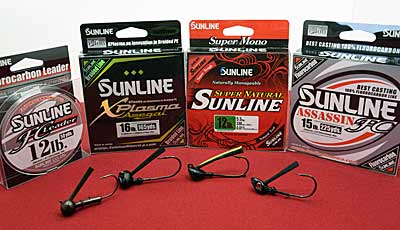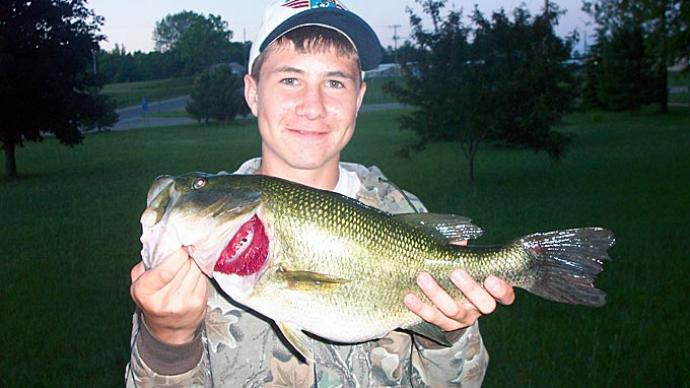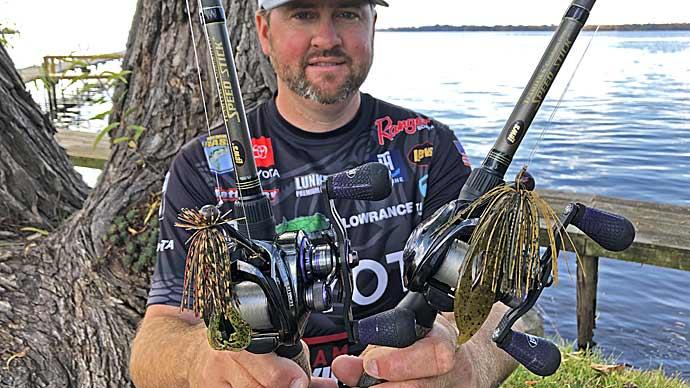
What bait would you choose if you could have one bass bait in your tackle box? Some fishermen would say a worm, while others may pick a spinnerbait. My number one choice would be a jig. I know that the day the ice goes off the lake, I can catch bass until the lake freezes back up again. Jigs can be fished on top down to the bottom, making it one of the most versatile baits in your tackle box. So, what are some of the bass jig 101 facts to help you put more bass in your livewell?
Match The Conditions With Your Jig
You can fish a jig in many different structure situations and weeds, rocks, mud, and all bottom compositions in between. Matching your jig head to the cover or bottom conditions you're fishing will help put more odds in your favor. You wouldn't take a football jig and fish deep into the weeds with it. You're best to carry a few of the many different types of jig heads that allow you to fish the areas correctly instead of making the same jig head work for you in all conditions you face fishing.
Take a closer look at the structures you're fishing in your bodies of water and carry the jig heads to match these structures in your tackle box, then expand from there as your water choices expand or new presentations come about. Make it your goal to master what you have and regularly fish.
Jig Head Breakdown That Match The Structure

Bullet Jig Head – These jigs came on the scene back in the early ’80s. You could say it kicked off on two front’s first, it was billed as the newest weed jig, as with the bullet head, it came through the weeds better than the old standard Arky jig head. After that started to take hold with many, it quickly became the standard head of choice for swim jigs as they were starting to come to light.
Arky Jig Head – This jig worked so well from day one that it still had to have a place in the jig lineup. Many anglers still pick and use this jig head as their number one choice to get bass out of cover. Yes, some of the bass fishermen have gravitated towards using a bullet head jig when it comes to flipping, but there is still a strong base that use an Arky Jig when it comes to flipping cover. Some fishermen shy away from the bullet head jig, saying it gets caught in the trees too easily where an Arky jig won't hang up in the branches.
Ball Head Jig – This is really where all bass jigs started from. Crappie jigs to bass jigs, you can't write off a ball head jig when it comes to bass fishing. It often is the forgotten jig head in today’s bass circles, but they still have a place in their jig box for hardcore bass fishermen. When paired with a skirt and trailer, many bass fishermen use the simple weedless ball head jig as their finesse jig.
Football Jig Head – When fishing deepwater rocks, you can't go wrong by choosing a football jig head. When you look at football jigs, you have two options that stand out; open hook models and weedless models. Take a close look at the location of the rocks that you're fishing and choose your football jig. You'll have a higher hookup ratio if you're fishing an open hook football when fishing on weedless rocks in deeper water because there is no weed guard. When fishing in a weed/rock mix, you don't have a choice. You'll have to use a football jig equipped with a weed guard to fish the jig clean.
Skirt Option Choices
Not only do you have to match the jig head to the structure conditions you're fishing, but you should match the skirt of your jig to the forage that you're trying to imitate. I'll match the skirt to the forage I'm trying to imitate in clear water conditions. This is called Match the Hatch. When bass can get a good look at your bait, you can get them to bite a jig that looks like what they are eating. When it's super tough, I can tell you that this is the only way to get bites. If your skirt match is a little bit off, that will be the difference in putting bass in the boat or not.
If I'm faced with fishing in stained to dirty water conditions, I'll often use a skirt color that imitates the forage, but I'll add accent colors to my skirt to start. I add strands of reds, orange, and chartreuse for accent colors. Many times, this slight color addition is all that is needed to get the bass to zero in on your jig and bite. Most of this is just the adjustment that helps them find the jig better.
Trailers
When it comes to trailers, you have as many skirt colors. Some fishermen are brand loyal, while others pick the best trailer to match the water and bass activity level they face on the water. I carry a bunch (probably too many) to help me give the bass what I think is needed.

Primary picks carry a handful of craw trailers to match the crawfish in your waters. Grub tails will allow you to give a few different looks with single and double tails. Also, add a few chunks into your trailer as well.
If you want to add a few accent colors to your trailers, make sure you carry a few Spike-It dips or markers. These will add accent colors to your plastics and add a garlic scent simultaneously.
Look at the water clarity and the action of your trailer. Use a toned-down craw action in clear water conditions to make the trailer look natural to the bass. In stained/dirty water conditions, use a trailer that has and gives off more action. The sound made from the active plastics will help the bass find and key in on your bait.
Jig Tweaks
Now that you have picked the proper jig head, skirt, and trailer. There are a few more things that you should pay attention to. I'll list these as jig tweaks.
Trim Your Weed Guard: Most of the weed guards coming on today’s jig are too long to begin with, and will need to be trimmed. I'll only need to level off the weed guard with the jig hook point if you're fishing in heavy weeds. I'll cut the weed guard at an angle, even with the hook point.
When fishing in moderate weeds, take some of the bulkiness of the weed guard out by trimming some of the strands out of the base of the weed guard. The best way to do this is to take a wire cutter and cut a few strands at a time till you cut the weed guard back to the desired thickness; then, you're best to take a few drops of super glue where you cut them at the base of the weed guard to hold it all together. Also, trim the weed guard at the hook's point at an angle.
How Sharp Is Your Jig Hook
Finally, check your jig hook point a couple of times a day to make sure it's sharp. Drag the hook point across your thumbnail. If it grabs, you're good to go. If it just scratches the surface of your thumb, you'll need to sharpen your hook. It's easier to hook a bass if your hook point is sharp instead of dull. Take the time a few times a day to make sure you have a sharp hook. It will result in more bass over the side of your boat.
Line Choice For Your Jig Fishing
Line choice is essential and a critical point that you need to pay close attention to and adjust to the bite conditions you face on the water. Most of the time, I use fluorocarbon lines for jig fishing. There is less stretch, and the line's visibility is virtually none. This will allow you to move up a line size or two and still trigger bites.

I often switch to braided line when fishing in windy conditions. The main reason for the switch is to feel my jig better. Braid has the least stretch of all three lines, giving you the best feel of what your jig is doing and when getting bites. My primary braid choice is Sunline Asegai. I'll often tie directly to the jig if I'm fishing in dirtier water conditions. Still, if I'm fishing in clear water conditions or worried about the fish seeing my braided line, I'll use a fluorocarbon leader. The fluorocarbon leader that I use is Sunline FC Leader material.
The last thing I want to talk about is when the bite is super tough. I'll switch to monofilament line for these reasons. First, mono floats. This will slow the fall of my jig down, keeping it in the strike zone longer, triggering more bites from reluctant biters.
The other reason is with all the no and low stretch lines that we use as well as we can feel the fish, I believe that they can feel us just as well, so by going to a line that has more stretch, I get more bites when the bite is super tough.
I hope a few of these bass jig 101 points will help you better prepare to fish a jig this season. Take the time to look at what you carry for jigs components and match them to the water conditions you're faced with when jig fishing your waters. Have the proper jig heads on hand, match your skirts and trailers to the forage in your waters, as this will help you put more odds in your favor when you hit the water this year.




